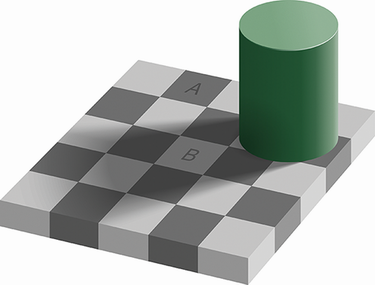If you search for “color optical illusions” in your favorite search engine, you’ll get a number of results, including some that look like the image is moving. This perceived movement is due to the color choices, the structure of our eyes, and our perception. The color choices that create the illusion are a part of the subject of color theory. One of the more famous color optical illusions, shown in figure 9.1, is Adelson’s checker-shadow illusion. A checkerboard appears to have a shadow cast over it by an object. The square labeled “A” appears darker than the square labeled “B,” but they are actually the same color when placed side by side.
Figure 9.1 Adelson’s checker-shadow is an optical illusion where squares A and B are the same color. (Source: Edward H. Adelson. Licensed under CC BY-SA 4.0)

Color theory is the science and art of applying color, how we perceive it, and the visual effects created when colors are mixed and matched, like in those optical illusions. At its most basic level, color theory has a defined set of guidelines and rules that helps us make color choices using the color wheel.